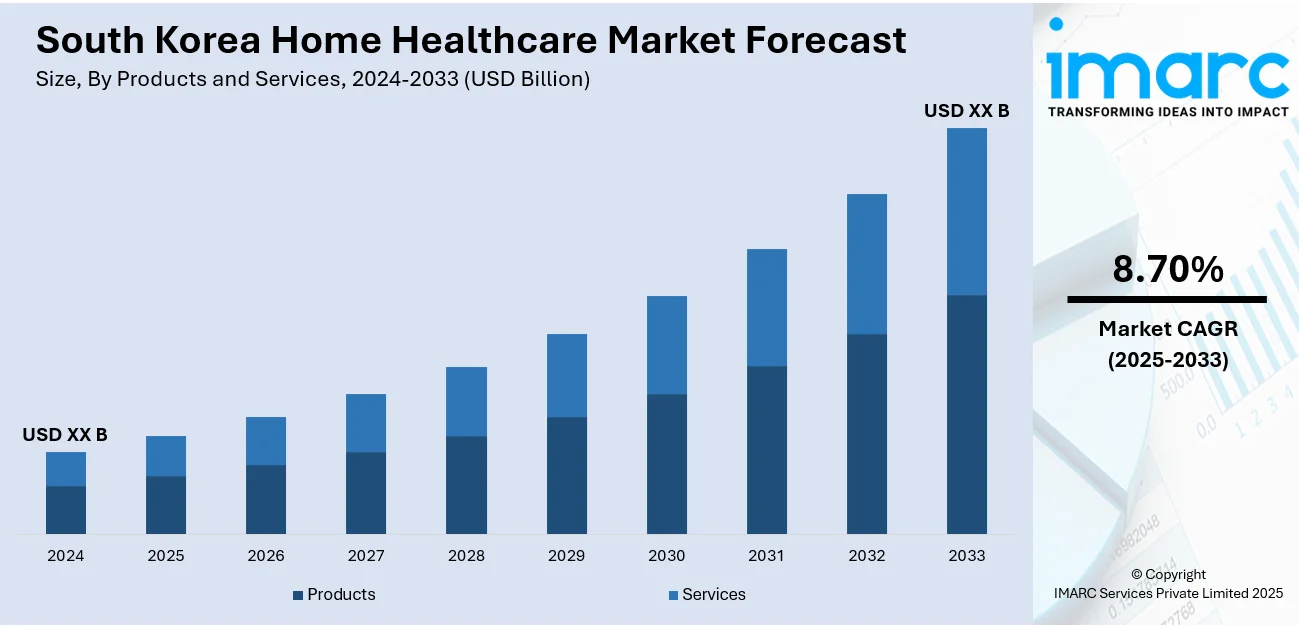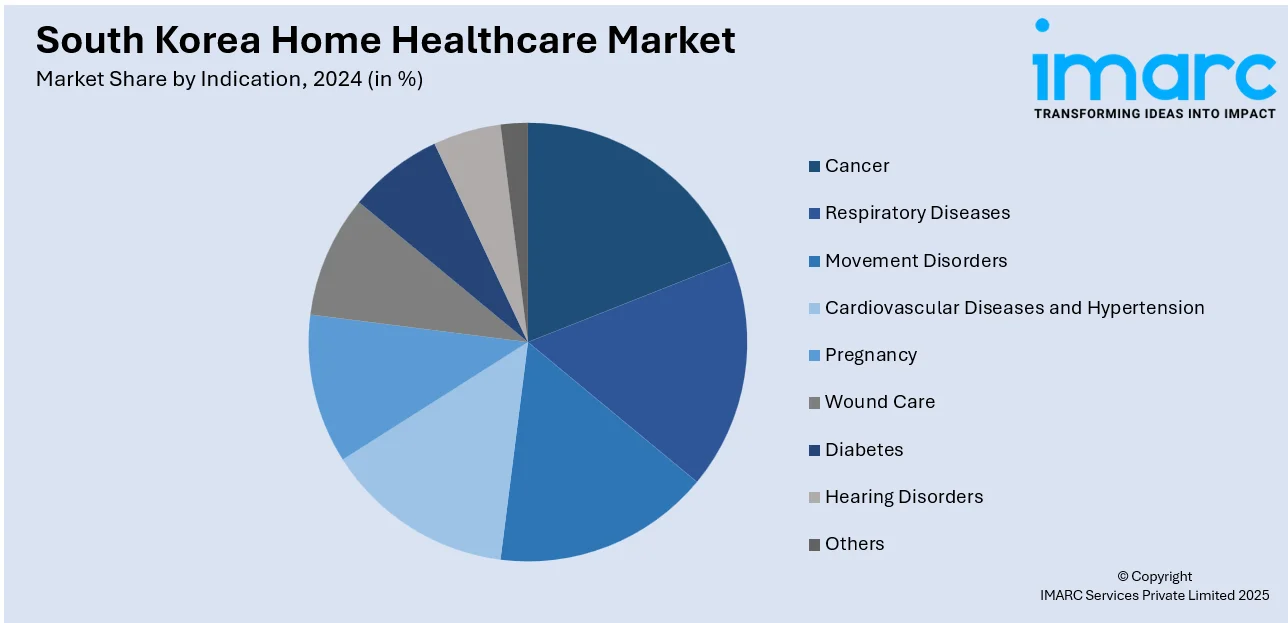
South Korea Home Healthcare Market Size, Share, Trends and Forecast by Products and Services, Indication, and Region, 2025-2033
South Korea Home Healthcare Market Overview:
The South Korea home healthcare market size is projected to exhibit a growth rate (CAGR) of 8.70% during 2025-2033. The South Korean government is contributing actively to the growth of the market through policy changes and incentives to enhance the affordability and accessibility of care. Moreover, the aging population and the growing incidence of chronic diseases are offering a favorable market outlook. Additionally, technological advancements are playing a major part in expanding the South Korea home healthcare market share.
|
Report Attribute
|
Key Statistics
|
|---|---|
|
Base Year
|
2024
|
|
Forecast Years
|
2025-2033
|
|
Historical Years
|
2019-2024
|
| Market Growth Rate 2025-2033 | 8.70% |
South Korea Home Healthcare Market Trends:
Aging Population and the Growing Incidence of Chronic Diseases
South Korea has one of the world's fastest-aging populations, which is why the country serves as a prime force driving the home healthcare industry. The United Nations estimates that South Korea's population aged 65 and older will grow to 40% by 2060. The need for healthcare services that cater to the unique needs of senior folks is growing as the population ages. For comfort, familiarity, and financial considerations, these individuals would rather receive treatment at home than in an institution. Furthermore, there is a growing need for ongoing medical treatment due to the prevalence of chronic diseases like diabetes, cardiovascular disease, and hypertension. With lower hospital readmission rates, home healthcare options including nursing care, rehabilitation, and remote monitoring are more practical and improve patients' quality of life. As per the Ministry of Interior and Safety, in 2024, South Korea officially transitioned into a “super-aged” society, as over 20 percent of its population was 65 years and older.

To get more information on this market, Request Sample
Healthcare Technology and Telemedicine Advancements
Technological advancements play a major part in supporting the South Korea home healthcare market growth. The industry is being driven by the country's strong emphasis on digital health solutions like telemedicine, health apps, and remote patient monitoring. Health professionals may now monitor patients' vital signs in real-time because to advancements in wearables, medical devices, and Internet of Things (IoT) technology. This enables prompt treatments and personalized care planning. Telemedicine technologies reduce the need for in-person visits by allowing patients to communicate with doctors and other healthcare professionals remotely. This is particularly advantageous for people who live far away or have mobility issues. Additionally, home care is made more efficient and convenient by the use of artificial intelligence (AI) and machine learning (ML) to improve the accuracy of diagnosis and treatment. In 2025, South Korea improved its mobile medical emergency app by enhancing the existing chat feature to shorten the consultation wait duration. A 24/7 chatbot feature is also integrated to clear queries about health and welfare-related policies.
Government Support and Healthcare Policy Reforms
Through incentives and legislative changes to improve care affordability and accessibility, the South Korean government is aggressively supporting the expansion of home healthcare services. The government has extended national health insurance coverage for home healthcare services including nursing and physiotherapy in an effort to lower costs for senior citizens. The market is also being driven by policies that encourage the use of cutting-edge healthcare technologies, such as telemedicine and e-health services. Additionally, efforts to improve home healthcare's integration with traditional healthcare systems are encouraging service delivery more easily, which enhances the patient experience. In light of an aging population and increasing healthcare expenses, the government is determined to create a sustainable model for home healthcare to address both current and future demands in the sector.
South Korea Home Healthcare Market Segmentation:
IMARC Group provides an analysis of the key trends in each segment of the market, along with forecasts at the country and regional levels for 2025-2033. Our report has categorized the market based on products and services and indication.
Products and Services Insights:
- Products
- Therapeutic Products
- Testing, Screening, and Monitoring Products
- Mobility Care Products
- Services
- Skilled Nursing
- Rehabilitation Therapy
- Hospice and Palliative Care
- Unskilled Care
- Respiratory Therapy
- Infusion Therapy
- Pregnancy Care
The report has provided a detailed breakup and analysis of the market based on the products and services. This includes products (therapeutic products, testing, screening, and monitoring products, and mobility care products) and services (skilled nursing, rehabilitation therapy, hospice and palliative care, unskilled care, respiratory therapy, infusion therapy, and pregnancy care).
Indication Insights:

- Cancer
- Respiratory Diseases
- Movement Disorders
- Cardiovascular Diseases and Hypertension
- Pregnancy
- Wound Care
- Diabetes
- Hearing Disorders
- Others
A detailed breakup and analysis of the market based on the indication have also been provided in the report. This includes cancer, respiratory diseases, movement disorders, cardiovascular diseases and hypertension, pregnancy, wound care, diabetes, hearing disorders, and others.
Regional Insights:
- Seoul Capital Area
- Yeongnam (Southeastern Region)
- Honam (Southwestern Region)
- Hoseo (Central Region)
- Others
The report has also provided a comprehensive analysis of all the major regional markets, which include Seoul Capital Area, Yeongnam (Southeastern Region), Honam (Southwestern Region), Hoseo (Central Region), and others.
Competitive Landscape:
The market research report has also provided a comprehensive analysis of the competitive landscape. Competitive analysis such as market structure, key player positioning, top winning strategies, competitive dashboard, and company evaluation quadrant has been covered in the report. Also, detailed profiles of all major companies have been provided.
South Korea Home Healthcare Market Report Coverage:
| Report Features | Details |
|---|---|
| Base Year of the Analysis | 2024 |
| Historical Period | 2019-2024 |
| Forecast Period | 2025-2033 |
| Units | Billion USD |
| Scope of the Report |
Exploration of Historical Trends and Market Outlook, Industry Catalysts and Challenges, Segment-Wise Historical and Future Market Assessment:
|
| Products and Services Covered |
|
| Indications Covered | Cancer, Respiratory Diseases, Movement Disorders, Cardiovascular Diseases and Hypertension, Pregnancy, Wound Care, Diabetes, Hearing Disorders, Others |
| Regions Covered | Seoul Capital Area, Yeongnam (Southeastern Region), Honam (Southwestern Region), Hoseo (Central Region), Others |
| Customization Scope | 10% Free Customization |
| Post-Sale Analyst Support | 10-12 Weeks |
| Delivery Format | PDF and Excel through Email (We can also provide the editable version of the report in PPT/Word format on special request) |
Key Questions Answered in This Report:
- How has the South Korea home healthcare market performed so far and how will it perform in the coming years?
- What is the breakup of the South Korea home healthcare market on the basis of products and services?
- What is the breakup of the South Korea home healthcare market on the basis of indication?
- What is the breakup of the South Korea home healthcare market on the basis of region?
- What are the various stages in the value chain of the South Korea home healthcare market?
- What are the key driving factors and challenges in the South Korea home healthcare market?
- What is the structure of the South Korea home healthcare market and who are the key players?
- What is the degree of competition in the South Korea home healthcare market?
Key Benefits for Stakeholders:
- IMARC’s industry report offers a comprehensive quantitative analysis of various market segments, historical and current market trends, market forecasts, and dynamics of the South Korea home healthcare market from 2019-2033.
- The research report provides the latest information on the market drivers, challenges, and opportunities in the South Korea home healthcare market.
- Porter's five forces analysis assist stakeholders in assessing the impact of new entrants, competitive rivalry, supplier power, buyer power, and the threat of substitution. It helps stakeholders to analyze the level of competition within the South Korea home healthcare industry and its attractiveness.
- Competitive landscape allows stakeholders to understand their competitive environment and provides an insight into the current positions of key players in the market.
Need more help?
- Speak to our experienced analysts for insights on the current market scenarios.
- Include additional segments and countries to customize the report as per your requirement.
- Gain an unparalleled competitive advantage in your domain by understanding how to utilize the report and positively impacting your operations and revenue.
- For further assistance, please connect with our analysts.
 Request Customization
Request Customization
 Speak to an Analyst
Speak to an Analyst
 Request Brochure
Request Brochure
 Inquire Before Buying
Inquire Before Buying




.webp)




.webp)












